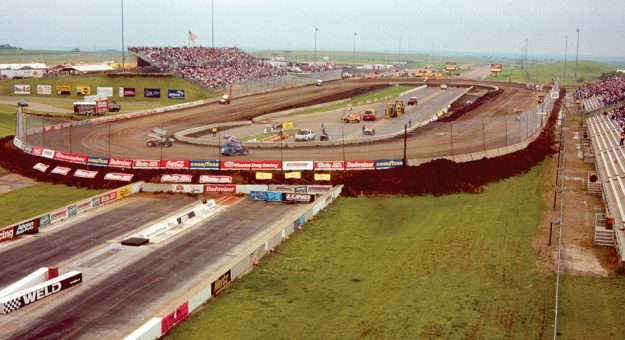Another driver that excelled in ‘99 was Johnny Herrera. After running near the front for much of Saturday night‘s feature, “Hollywood” took home the big trophy from the Sunday finale.
By the drop of the checkers on Sunday, the event had been deemed a complete success, and track management committed to constructing a dirt track again in 2001, this time with the intention of bringing in one of USAC‘s divisions to race on the elongated oval as well.
To the credit of Kentling and Landrum, the duo made note of areas they needed to improve upon when constructing the track the following year.
Kentling told this writer that the racing surface in the corners would be made wider — instead of the 67-68 foot wide corners of the ‘99 track, the corners would be 80-85 feet wide for 2000.
Landrum shared that other areas had fallen through the cracks, and would be addressed the following year. For example, they neglected to make an entrance through the fence by the flagstand.

Though not a major problem, it did make it necessary for a four-wheeler to transport the flagman around the outside of the first turn, through the track entrance in turn two and around the track to the frontstretch in order to present race winners with a checkered flag to hold during trophy presentations.
For 2000, the second annual O‘Reilly Auto Parts Sunflower Shootout at Martin Cat Speedway at Heartland Park Topeka saw the World of Outlaws scheduled for three nights, instead of two, from Thursday, June 15 through Saturday, June 17.
In addition, the USAC National Midget Series made an appearance on June 9.
When the USAC midgets towed into Topeka, Jay Drake put himself in the field by winning the semi, then earned the win in the feature.
The Outlaws‘ return saw Sammy Swindell start strong, taking the win in the Thursday night prelim. The event saw a unique format, with points tallied from both preliminary nights and the top four in points locked into the first four starting positions in Saturday‘s A-main.
Hillenburg returned to victory lane in the Friday night prelim, and put himself second in points. He started the Saturday feature alongside polesitter (and high point man) Craig Dollansky. Steve Kinser and Sammy were third and fourth in points, respectively, and made up row two.
The rest of the participants raced their way through Saturday‘s program to earn a position in the starting field of the finale.
Several spins and accidents necessitated repeated attempts to get the Saturday A-main underway. But, when the first lap was finally completed, it was Hillenburg out front.
Hillenburg held the point for the duration, leading all 30 laps and collecting his third feature win out of the total of five nights of racing competed on the two versions of the temporary track.
Once again strong crowds had graced the grandstands, and for 2001 a permanent three-eighths-mile dirt track was constructed. The new track sits behind one of the dragstrip grandstands, and is a much more sweeping oval.
That year, Donny Schatz claimed the first World of Outlaws sprint car victory on the permanent track.
Despite its flaws, Heartland Park‘s temporary track made a significant contribution to the growth of the Outlaws, particularly the 1999 running.
Ted Johnson was right. The stature of the facility, combined with the uniqueness of the races being competed on a temporary track had attracted a lot of attention, and the pressure had been on to make the event a success.
Despite its odd shape, and drivers‘ dislike of the formation, the racing — televised on TNN both years — was very good, with plenty of action.

Bill Kentling had estimated that building the temporary dirt track in 1999 had been a $150,000-$175,000 investment.
However, between the two nights of World of Outlaws racing and the other series that competed on the oval, the gamble had paid off and Heartland Park ended up in the black.
At the time, the World of Outlaws were still considered a grassroots series, with sanctions like NASCAR, the Indy Racing League and the NHRA serving as the big leagues of American auto racing.
To have events run at the same facilities as those sanctions was a big step for the image of the Outlaws. It was a time when the term “the next level” was thrown around extensively when discussing hopes for the future of the series.
Certainly keeping an eye on the events at Topeka was SMI‘s founder and CEO Bruton Smith, who was marching forward with his own investments.
The Texas Motor Speedway Dirt Track was completed in March of 2000, and The Dirt Track at Charlotte Motor Speedway was completed that May.
In addition, following the success of the ‘99 event at Topeka, Bristol Motor Speedway (owned by SMI) was covered in 1,400 dump truck loads of dirt in the spring of 2000 to host a two-day World of Outlaws event that saw over 45,000 fans attend the Saturday evening finale. Bristol again covered the track in red dirt in 2001.
“It was a very exciting time,” Hillenburg recalled. “And, I kind of liked those venues — and you‘re probably going to think I‘m crazy — but, remember, we got to park on the blacktop, and the motorhomes were on the blacktop. You didn‘t even get your tennis shoes dirty.
“That was pretty nice,” he added with a laugh.
Summing up the temporary track at Topeka, he noted, “That was an awesome track, you know, as far as a great venue, and a great idea.”
It was a great idea that changed the course of dirt-track racing.![]()
